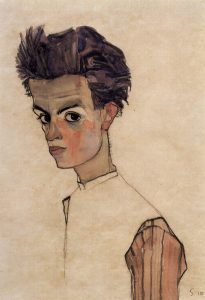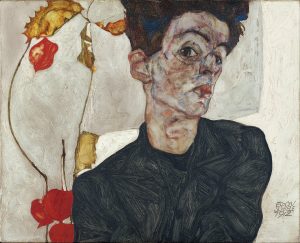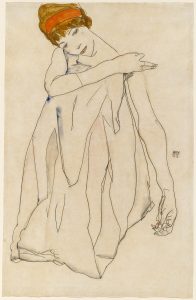Egon Schiele was an important Austrian figurative painter of the early 20th century. He was a pupil of Gustav Klimt, and his work is known for its intense and its raw sexuality, and for the numerous self-portraits including nude self-portraits.

Image source: https://en.wikipedia.org/wiki/File:Egon_Schiele_-_Sitzende_Frau_mit_hochgezogenem_Knie_-_1917.jpeg

Image source: https://en.wikipedia.org/wiki/File:Egon_Schiele_-_Auf_dem_Bauch_liegender_weiblicher_Akt_-_1917.jpeg
With his distinctive graphic style, figurative distortion, and defiance of conventional norms of beauty, Egon Schiele was one of the leading figures of Austrian Expressionism. His portraits and self-portraits, explore the psyche and sexuality of their models and are among the most notable of the 20th century.
Early life and education

Image source: https://en.wikipedia.org/wiki/
Schiele was born in 1890 in Tulln, Lower Austria. His father, Adolf Schiele, was born in 1851 in Vienna and was stationmaster of the Tulln station on the Austrian State Railways. As a child, Schiele was fascinated by trains, and spend many hours drawing them, so much so that his father felt obliged to destroy his notebooks.
To those around him, Schiele was considered a strange child. Shy and reserved, he did poorly at school except in athletics and drawing and was placed in classes made up of younger pupils. He also showed incestuous tendencies towards his younger sister Gertrude (known as Gerti), and his father, aware of Egon’s behavior, once had to break down the door of a locked room where Egon and Gerti were staying to see what they were doing (only to find out they were developing a film). At the age of sixteen, he took 12-year-old Gerti by train to Trieste without permission and spent a night with her in a hotel room.
Who was his mentor?

Image source: https://en.wikipedia.org/wiki/File:Egon_Schiele_016.jpg
The painter Gustav Klimt was a profound influence on Schiele’s development, becoming his friend and mentor. Schiele inherited from Klimt the focus on erotic images of the female form (and shared his insatiable sexual appetite), Schiele’s emotionally intense, and often disturbing Expressionist idiom eventually developed, with his investigation of inner life and emotional states of his designs, somewhat opposing his mentor’s Art Nouveau–inspired style, with Klimt favoring a brighter palette and shimmering, patterned surfaces.
Portraits

Image source: https://en.wikipedia.org/wiki/File:Egon_Schiele_075.jpg

Image source: https://en.wikipedia.org/wiki/Egon_Schiele
Schiele’s portraits and self-portraits helped restore the vitality of both genres with their emotional and sexual immediacy and the use of figurative distortion in place of conventional notions of beauty. Often portraying himself or people close to him, Schiele’s portraits often present their subjects naked, posed in revealing and disturbing angles—often seen from above—and devoid of secondary attributes often depicted in the portrait genre. At times, Schiele used traditional motifs, giving the intensely personal images a more general, and allegorical statement about the human condition.
A love for sketching

Image source:https://search.creativecommons.org/photos/44cec74d-4ab1-4d91-848e-73cbd0576a84

Image source: https://en.wikipedia.org/wiki/File:Egon_Schiele,_Dancer_(Die_T%C3%A4nzerin),_1913,_NGA_71829.jpg
Throughout his short career, Schiele was an extraordinarily prolific and unparalleled draftsman, creating some three thousand drawings. He regarded drawing as his primary art form, appreciating it for its immediacy of expression, and produced some of the finest examples of drawing in the 20th century. His pictorial work also revealed a style that took up some of the characteristics of the drawing, such as its emphasis on the outline, graphic sign, and linearity.
Info sources: https://www.theartstory.org/artist/schiele-egon/ https://en.wikipedia.org/wiki/Egon_Schiele https://www.christies.com/features/
